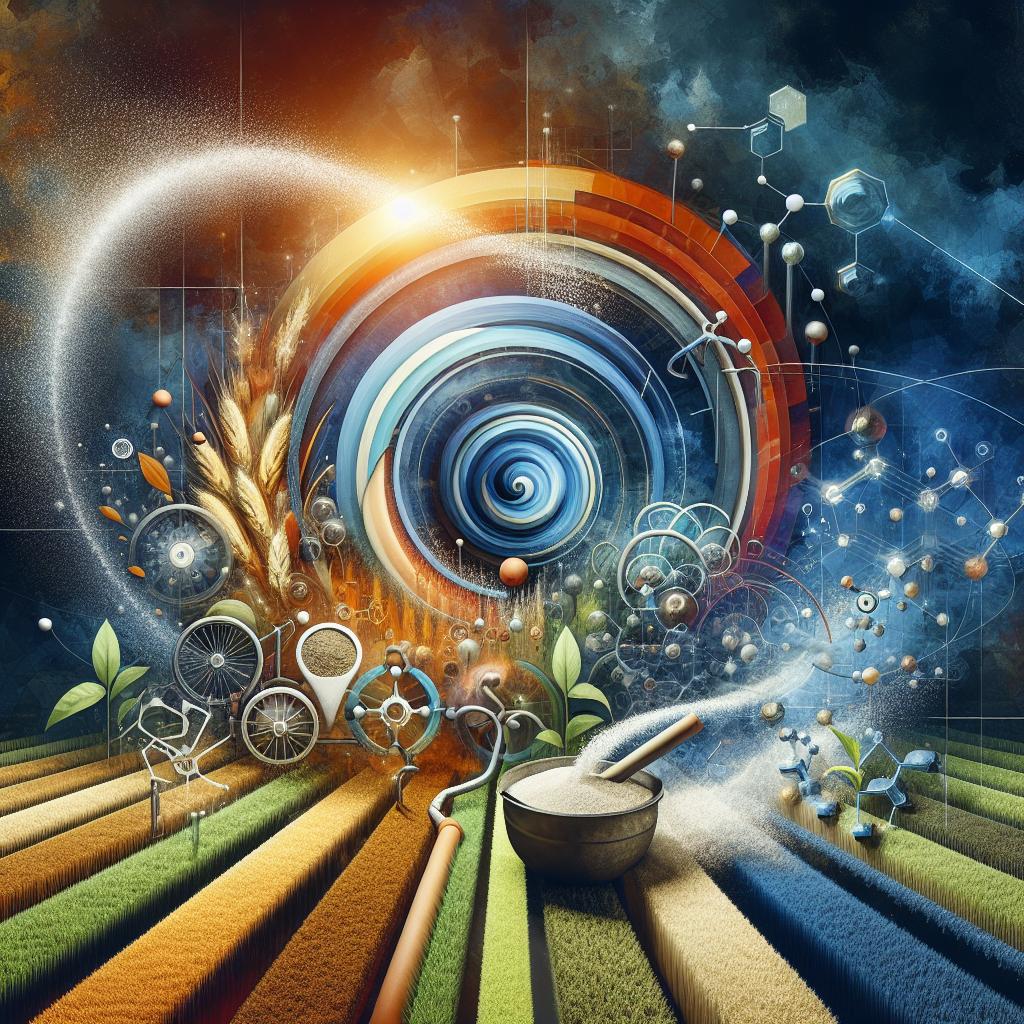This post may contain affiliate links which means I may receive a commission for purchases made through links. Learn more on my Private Policy page.
Unlocking the Secrets of a Flourishing Garden: A Friendly Guide to Incorporating Fertilizer and Nutrients into Your Irrigation System
Imagine stepping into your garden, where vibrant blossoms sway in the gentle breeze and fresh vegetables gleam with promise under the sun. This picturesque scene doesn’t just happen by chance; it’s the result of a harmonious blend of nature’s elements,especially when it comes to nurturing the soil. As any seasoned gardener knows, balancing water and nutrients is key to turning your green space into a thriving paradise. But why limit yourself to standard watering practices? Picture this: a seamless irrigation system that not only quenches your plants’ thirst but also feeds them with essential nutrients at the same time. Welcome to the realm of integrated irrigation and fertilization! in this article, we’ll explore how to transform your watering routine into a nutrient-delivery powerhouse. Let’s dive into the art of nourishing your plants effectively and effortlessly, ensuring that every drop of water works double-time to promote the lush, healthy garden you’ve always dreamed of!
Understanding the Basics of Fertilizer integration in irrigation Systems
Integrating fertilizer into your irrigation system can substantially enhance the efficiency of nutrient delivery to your crops. By adopting this method, you streamline the feeding process, allowing plants to absorb nutrients directly through the water supply. To successfully implement this technique, consider the following factors:
- Type of Fertilizer: Choose between liquid or soluble fertilizers based on your system’s requirements and the specific needs of your plants.
- Pumping Systems: Ensure your pump can handle the added viscosity of the fertilizer solution without compromising water flow.
- Request Rate: Monitor and adjust the nutrient concentration to prevent over-fertilization, which can harm plant health and affect water quality.
Setting up an effective fertilizer integration involves understanding how nutrients interact with water and soil. You can benefit from using a simple table to organize the nutrient types, thier benefits, and recommended application rates for various crops:
| Nutrient Type | Benefits | Application Rate (lbs/acre) |
|---|---|---|
| Nitrogen | Promotes leafy growth | 100-150 |
| Phosphorus | Enhances root progress | 20-60 |
| Potassium | Improves resistance to disease | 50-100 |
By understanding these fundamentals, you can create a balanced fertilization plan that complements your irrigation method, resulting in healthier plants and improved crop yields.Happy farming!

Choosing the Right Nutrients for Your Plants and Soil
When it comes to nourishing your plants, understanding their specific nutrient requirements is crucial. Different plants have differing needs based on their growth stage, species, and environmental factors. For instance, vegetables may require higher levels of nitrogen during their initial growth, while flowering plants often benefit from increased phosphorus. To ensure optimal health and yields, consider the following essentials:
- Nitrogen (N): Promotes lush, green foliage and overall plant growth.
- Phosphorus (P): Essential for strong root development and flowering.
- Potassium (K): Supports overall plant health, disease resistance, and fruit quality.
- Micronutrients: Boron, iron, and zinc are vital for various plant functions, even in small amounts.
One effective way to align your irrigation system with these nutrient needs is to utilize a drip feed fertilizer system. This method allows for precise nutrient delivery directly to the root zone. By mixing the right fertilizers into your irrigation water, you can enhance the efficiency of your watering routine, minimizing waste while maximizing nutrient uptake. below is a simple comparison of common fertilizers that can be integrated into your irrigation system:
| Fertilizer Type | Benefit |
|---|---|
| Liquid Fertilizer | Fast-acting and easy to incorporate with irrigation. |
| Granular Fertilizer | Slow-release, less frequent applications needed. |
| Organic fertilizer | Improves soil health and boosts microbiome activity. |
| Water-soluble Fertilizer | Mixes easily with water, ideal for foliar feeding. |

Techniques to Optimize Fertilizer application through Irrigation
One effective technique for optimizing fertilizer application through irrigation is the use of fertigation. This method allows you to deliver nutrients directly to the root zone of plants through irrigation systems,ensuring more efficient absorption. By adjusting the concentration of fertilizer mixed with water, you can tailor your nutrient delivery based on plant growth stages. Some benefits of fertigation include:
- Reduced nutrient wear and tear on plants
- minimized runoff and leaching
- Enhanced nutrient efficiency
Another method to consider is the timing of irrigation in relation to fertilizer application. Combining irrigation with nutrient delivery ensures that the moisture content in the soil helps dissolve and transport fertilizers to plant roots quickly. It’s essential to schedule your irrigation wisely—sometimes twice a week and sometimes more frequently during peak growth periods. Here’s a simple table illustrating the optimal irrigation and fertilizer schedule:
| Growth Stage | Irrigation Frequency | Fertilizer Type |
|---|---|---|
| Seedling | Every 3 days | Liquid NPK |
| Vegetative | Every 2 days | Granular Urea |
| Flowering | Every day | Calcium Nitrate |
By employing these strategies, you can enhance your fertilization efforts, making them more effective while conserving resources. Proper application helps promote healthy plant growth and maximizes yield potential!

Troubleshooting common Challenges in Nutrient Delivery Systems
When integrating fertilizer into your irrigation system, various challenges may arise. ensuring that the nutrients are delivered efficiently can be a daunting task. Common issues include clogging of emitters due to sediment in fertilizers, uneven distribution of nutrients, and compatibility of various fertilizer types with your irrigation setup. To tackle these challenges, consider the following solutions:
- Regular Maintenance: Clean filters and emitters frequently to prevent clogs.
- Water Quality Testing: Test your water source to identify any contaminants that could affect nutrient delivery.
- Nutrient Compatibility: Consult with a professional to ensure that the fertilizers you choose won’t react negatively with your irrigation system.
An effective way to monitor your system’s performance is by implementing a schedule for frequent checks. Create a simple log that captures factors like nutrient concentration and pressure levels. In addition,using a fertilizer injector with adjustable flow rates can help maintain consistent nutrient levels. Here’s a quick overview of some key elements to monitor:
| Element | Recommended Action |
|---|---|
| Emitter Pressure | Check weekly for consistent flow |
| Nutrient Concentration | Test monthly for desired levels |
| Log Form | Maintain a record for reference |
To Wrap It Up
As we wrap up our journey through the vibrant world of integrated irrigation and fertilization, we hope you feel inspired and equipped to nurture your garden like never before. Remember, incorporating fertilizer and nutrients into your irrigation system isn’t just a task—its an art! With a sprinkle of knowledge and a dash of creativity, you can transform your plants into flourishing masterpieces.
Whether you’re tending to a small herb garden on your windowsill or managing a sprawling landscape, the key is to find balance and harmony. Embrace the technology available, experiment with different nutrient blends, and, most importantly, listen to your plants—they’ll tell you when they’re thriving!
So, grab your watering can and your trusty fertilizer, and let’s set off on this green adventure together. Here’s to healthier, happier plants and a garden that inspires awe. Happy gardening,and may your irrigation system flow with the gift of nature’s bounty! 🌱💧✨
This post may contain affiliate links which means I may receive a commission for purchases made through links. Learn more on my Private Policy page.

